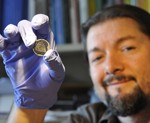Herbst, Greenwood Co-Author Article on Chondrules

Bill Herbst, the John Monroe Van Vleck Professor of Astronomy, and James Greenwood, assistant professor of earth and environmental sciences, co-authored an article published in the planetary science journal Icarus. Their article, “A New Mechanism for Chondrule Formation: Radiative Heating by Hot Planetesimals” grew out of research seminars from the recently introduced Planetary Science graduate concentration and minor at Wesleyan.
Their work focused on chondrules, or tiny spheres of molten rock that permeate primitive meteorites and date to very close to the beginning of the solar system.
For decades, the existence of chondrules has puzzled astrophysicists and cosmochemists as no obvious heat source exists at the time and location of their formation. Herbst and Greenwood set out to find this elusive heat source by combining their expertise in astronomy and earth science, respectively.

“It could be that the heat source is hot lava — oceans of magma– that may appear on nascent planets in their earliest days. The heat source is radioactive decay of a short-lived isotope of Aluminum, incubated in planetesimals with the size of small asteroids and brought to the surface as molten rock,” Herbst said.
Most of the material available for planet formation ends up on a planet very early on. A few “lucky bits,” represented by the primitive meteorites, avoided collision with a planet until just recently.
“It is, perhaps, not surprising that many, if not all of them, had a close encounter with a hot planetesimal that produced the chondrules and, likely, the chondritic meteorite in which they are embedded,” he said.

